If you look at the Apple’s revenue break-up, you will come across a comparatively small segment called “other services”. This small segment of other services, including iTunes, App store, Apple pay, etc., generated $8.5 billion for Apple in 2017 and over $110 billion since 2008. What appeared to be yet another mp3 player in the market had a solid business model behind it in the form of itunes. It completely transformed the music industry.
An innovative business model has the potential to radically disrupt a market and give your business the competitive edge. Especially, the emerging technologies require new business models to fully realise its value. Just like the advent of cloud technology that is substituting the model of selling software through perpetual licensing with the SaaS model.
In this blog, we look at some of the business models that have revolutionized the digital economy and address the crucial elements that determine the success of each model. We have left out some of the common models such as standardization, direct selling etc, as they have been discussed plenty.
- The freemium model
- Product-as-a-service (PaaS)
- Multi-sided platform
- Subscription model
- Software-as-a- Service (SaaS)
- Time-sharing business model
- Community-based business model
- Crowdsourcing
1. Freemium
Combination of the words ‘free’ and ‘premium’, freemium is quite a famous business model. The company offers a basic version of the product for free and charges for the premium version. The idea behind the premium model is that when you provide the basic functionalities of product for free, it will attract a large number of users to try the product, some of whom can be eventually turned into paying customers.
The question often cited in this model is “What is the free-to-premium conversion ratio?” However, it is not uniform for all businesses. Take Dropbox, for example. Dropbox has approximately 500 million total users and 11.9 million paying customers, giving them a conversion of 2.38% and an annual revenue of approximately $1.3 billion. The average revenue from a paying customer is $109.
But if you take Slack, which has 4.4 million daily paying customers out of a total of 11.5 million users, giving them a whopping 38% free-to-premium conversion. With a revenue of $486 million, the average revenue per paying customer is $110.
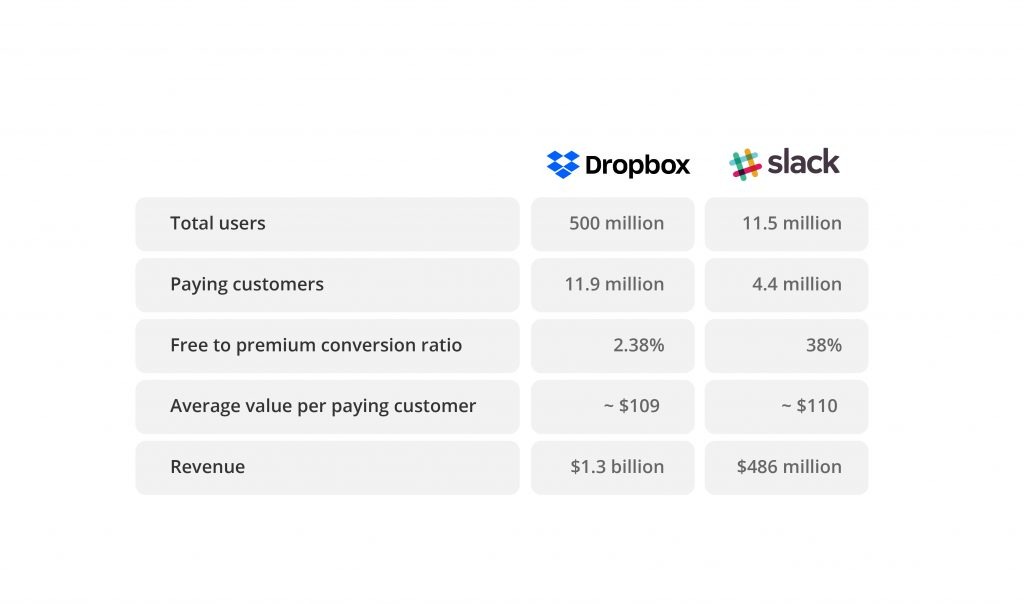
And there is Linkedin for which the freemium model only constitutes 17% of its total revenue, while it has 21% of its users using the premium subscription. The rest of it comes from talent solutions and advertising while it has 21% of its users have premium subscription. Here, the freemium model acts as the secondary or tertiary source of revenue.
Hence, when it comes to the freemium model, there is no standard conversion ratio as it varies from segment to segment and business to business. But the basics of the business model remain the same.
The trick is to decide what features of the product will be available for free and what will fall under the premium package.
The free version should be compelling so that it attracts plenty of users.The premium version should be even more compelling so that your users are willing to pay for it.
2. Product-as-a-service model (PaaS)
Why own it when you can rent it?
When the liability of owning exceeds the value derived, this business model becomes lucrative to the consumer.
“Product-as-a-service” is typically a capital-intensive, low profit margin business and cost optimization is crucial to success. Zipcar is a classic example of this model. The company owns a fleet of 12,000 vehicles across 500 cities. According to Zipcar, its members save on an average of $600 per month compared to owning a car.
There are plenty of companies who have used this model of renting cars for decades such as Enterprise Rent-A-Car. But what makes Zipcar tick is the convenience it brings to customers by leveraging the technological innovations. Customers can easily locate the cars closer to them, can unlock the cars with their zipcards and more. Thereby not only offering ease and convenience to its customers, it also eliminates the manual intervention as much as possible thus reducing the operational costs.
The bottomline for this model is to strive to improve on the value delivered while reducing the cost structures to maximize the profit margin.
But is there a way to mitigate this high overhead costs? This brings us to our next business model.
3. Multi-sided platform model (MSP)
Commonly referred to marketplace or platform model, this model facilitates direct/indirect interaction between two or more parties where all parties are affiliated to the platform.
As in the case of Airbnb, the company connects property owners (in the broader sense) with people looking to rent properties on a short-term basis. Without owning a single property unlike the leasing model, the Airbnb platform lists over 5 million property listings in 81,000 cities, making it the world’s largest property online rental marketplace. Such is the power of MSPs. The company makes money by charging 6%-12% commision for every booking from the host and ~3% charge for the users booking the property.
Further, MSPs can be classified depending on the product/service or the segment they serve. The following infographic shows the classification of different types of MSPs.
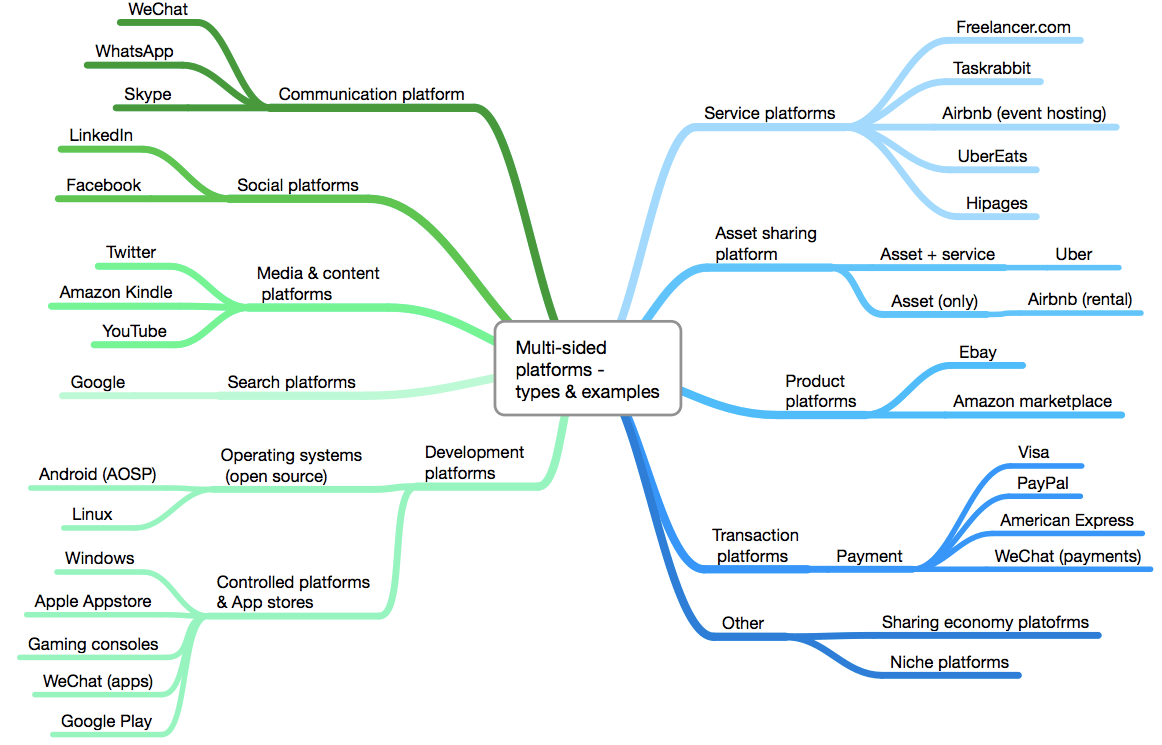
Source: Innovationtactics
As defined by Andrei Hagiu,
An MSP provides a support that facilitates interactions (or transactions)among the two or more constituents (sides) that it serves, such that members of one side are more likely to get on board the MSP when more members of another side do so.
The key here is the second part of the definition,
such that members of one side are more likely to get on board the MSP when more members of another side do so.
This brings the powerful and crucial network effect into play, requiring a delicate balance of supply and demand. The network effect is not uniform for all businesses and its effect varies from business to business.
In an interview by Marketplace Academy with James Currier, he explains the four different types of network effects. He goes on to cite the example of Airbnb and Uber.
For Airbnb, the more customers you have, the more attractive the marketplace is for the providers, and vice versa.
If you have an asymptotic network effect, it means that after you reach a certain threshold, the network effect loses its power. As an example: once you have more than 400 drivers using your ride-hailing app in a city, you can’t really improve the customer experience by getting more drivers on board.
So, if you are considering a multi-sided platform business model, it is essential to pay attention to the Network Effect. And the most important thing to bear in mind is that, your platform should enable interaction between two or more parties, which would not have been possible or would be difficult in the absence of the platform.
3. Subscription model
It is a relatively common business model that we can see in everyday life, from newspapers to gym subscription. The company provides product or service and charges the customer on a monthly, quarterly or annual basis. This offers the customers flexibility in terms of payment while guaranteeing revenue for the company when a customer opts of long-terms plans.
Netflix is the one of the best examples employing this model. By leveraging the Internet boom, it disrupted the industry put Blockbuster out of business.
Subscription works best when used in conjunction with other models. Recently, the model has been combined with the e-commerce model and has given rise to a new sub-segment called ‘subscription boxes’. Dollar Shave Club and Birchbox are well-known examples of this model. This segment has become wildly famous, and it has 16 sub-categories such as women’s, kid’s, pet’s, and eco-friendly subscription boxes.
You can learn more about the keys to building a successful subscription business here.
4. SaaS model
Software-as-a-Service is often mistaken for the subscription-based business model. Although a lot of SaaS companies have a subscription-based revenue generation/payment model, what makes SaaS unique is the mode of product delivery and the advantages it offers the customers.
For the customer
In the SaaS model, the customer need not worry about the infrastructure required to run the software. It is the responsibility of the vendor to provide resources such as security features, servers, etc. The deployment is extremely fast and the SaaS companies have also stepped up their customer support and knowledge transfer process. What took months with a perpetual license model can now be completed in just a matter of hours.
For the company
Unlike other subscription services where a product is made specifically for a customer, SaaS products are not made specifically for one customer and do not require extensive customization thus offering a high profit margin for the companies. For both SaaS and subscription models, the biggest enemy is churn. Your business might be growing, but a high churn rate can kill your business.
Here are a tips from McKinsey that could help you reduce churn.
5. Time-sharing business model
As the title suggests, in this model the customers buy the “right-to-use” a property in advance for a certain amount of time shared with other owners.
For example, a vacation home can be shared by 50 individuals, each earning the right-to-use for one week a year.
There are different variations to this mode such as fixed time-sharing, floating time-sharing, shared ownership, etc. You can read more about time-sharing property here. Though it was first invented in the hospitality (vacation homes), the model has been successfully adapted in a few other industries such as the private jet industry.
NetJets for example, sells private jets to owners on a time-sharing model. The image below is excerpt from the its website and should give you an idea of about how the model works.
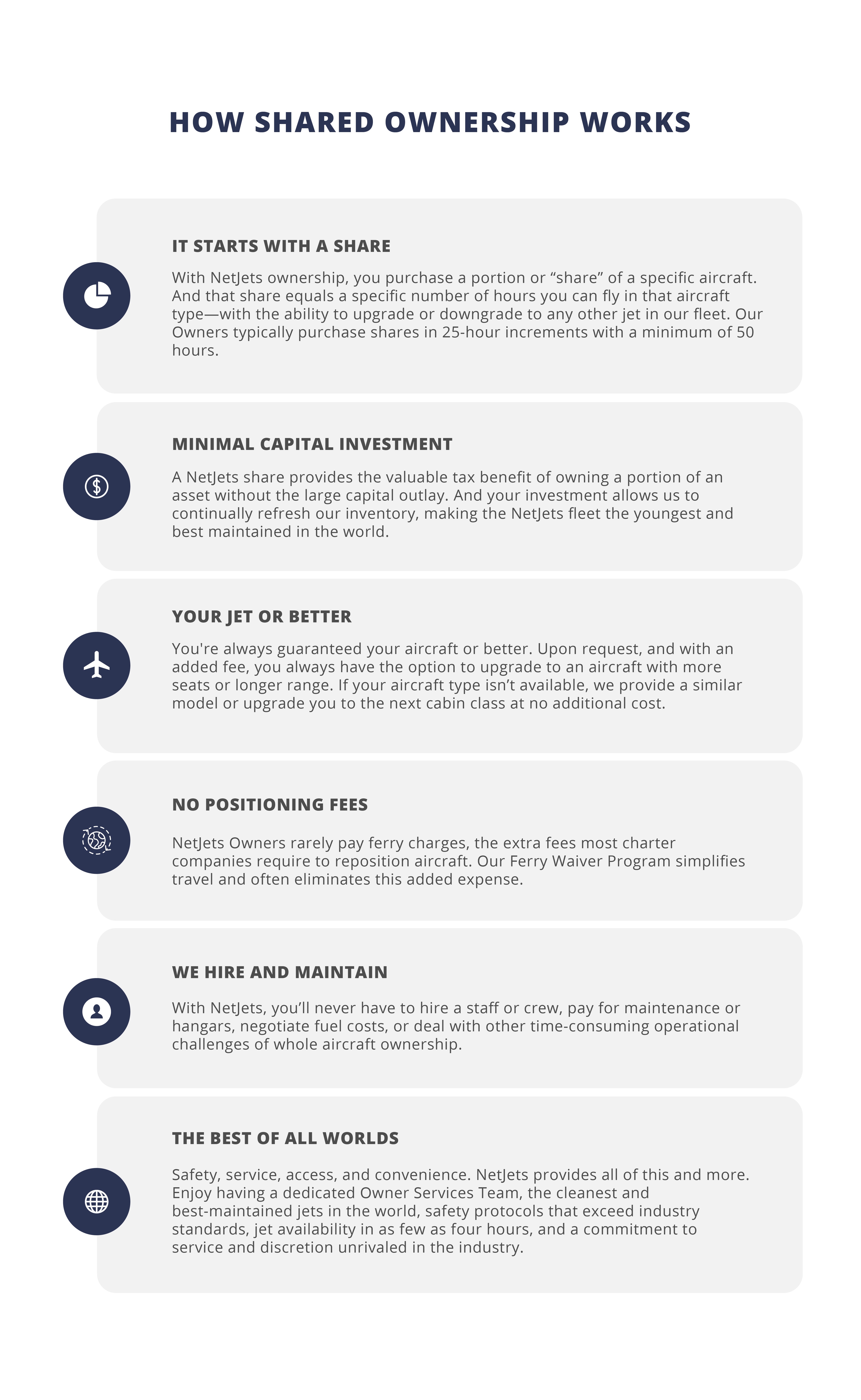
Source: NetJets
Though the value delivered to the customer is similar to the “Product-as-a-service” model, one key differentiating factor is that customers buy the right-to-use the property in advance here, thereby guaranteeing it at the time of need.
6. Community model
The company builds a community around a shared interest, passion or profession. The revenue structure is created by selling products/ services that is intended to create value for the community. Unlike an advertisement-driven business model, such as Facebook, where the company monetizes customer data by selling it to third-party advertisers, the community-based business model needs to be very selective about the product/ service it sells or advertises.
For example, Stack Overflow — a knowledge sharing platform for developers/ programmers, lets users ask questions on computer programming and get answers from other members of the community. The site has over 9 million registered users and monetizes via Stack Overflow Career services. The portal allows companies to hire developers and adds value to the users by allowing them to discover jobs.
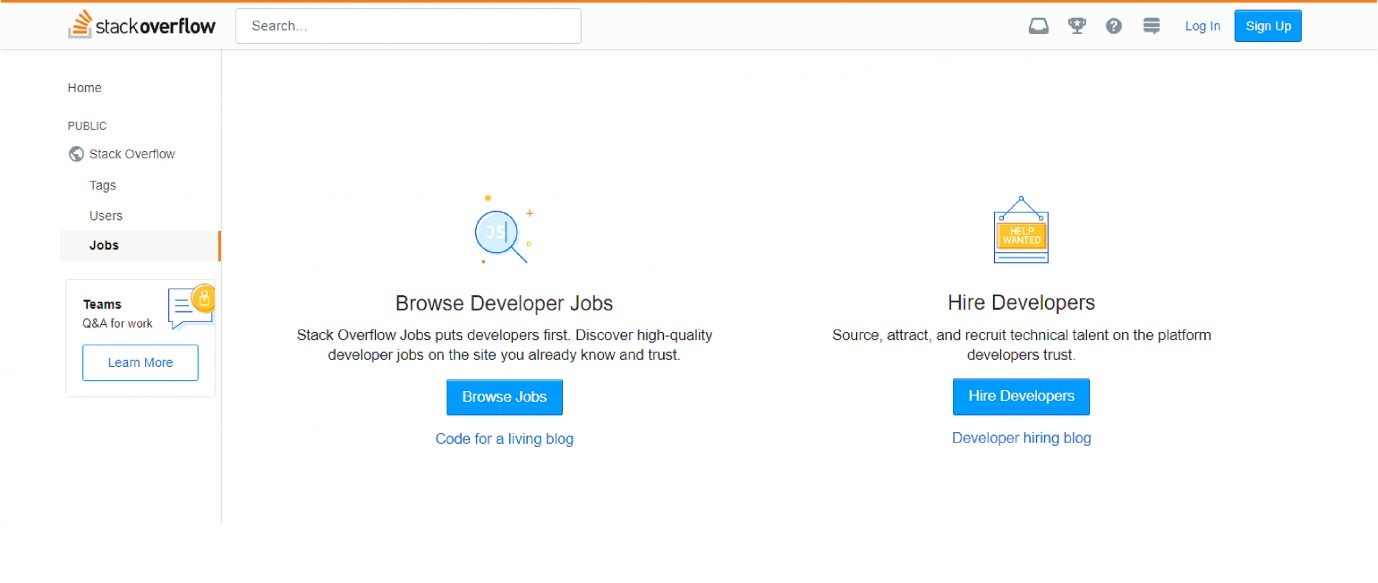
The success of a community-based depends on the “quality of the community members” which in turn depends on the value the platform it brings to the users. Stackoverflow has consistently taken measures to improve the quality of the memers. In 2009, the company introduced Penalty Box to suspend users (up to a year) who show no effort to learn and improve over time and show disruptive behavior.
This also means, a community-based business has to say NO to certain revenue streams and is always striving to maintain the trust and satisfaction of the community members. As Joel Spolsky, the CEO of Stack Overflow, mentions in his blog,
Everything about how Stack Overflow works today was designed to make programmers’ jobs easier. We let members vote up answers, so we can show you the best answer first. We don’t allow opinionated questions, because they descend into flame wars that don’t help people who need an answer right now. We have scrupulously avoided any commercialization of our editorial content, because we want to have a site that programmers can trust.
Inshort: the success of a community-based business heavily depends on the quality of the users. Hence, ensure the policies and practices maintain that.
8. Crowdsourcing model
The model is run using the crowd as a catalyst for a core business function such as product development, innovation, sales, etc.
Threadless, which has been the poster child for the crowdsourcing business model, is an online T-shirt company that crowdsources design. Anybody can submit a design. The crowd then scores it, and the best designs are sent to production and marketed. The winner of the design gets cash prize and as the company puts it, “the world get to buy your design.”In the case of Threadless, the business model is used for crowdsourcing designs, which in the t-shirt business is product development. The company then handles the manufacturing, sales, and marketing. To a large extent, the community is used for marketing the product as well.
The power of crowdsourcing can be used in place of labor, influence, capital, assets, and data. In terms of functions, companies use it to crowdsource R&D, Operations, Marketing, and Sales.
The following image shows the usage of the crowdsourcing business model for various business requirements and activities.
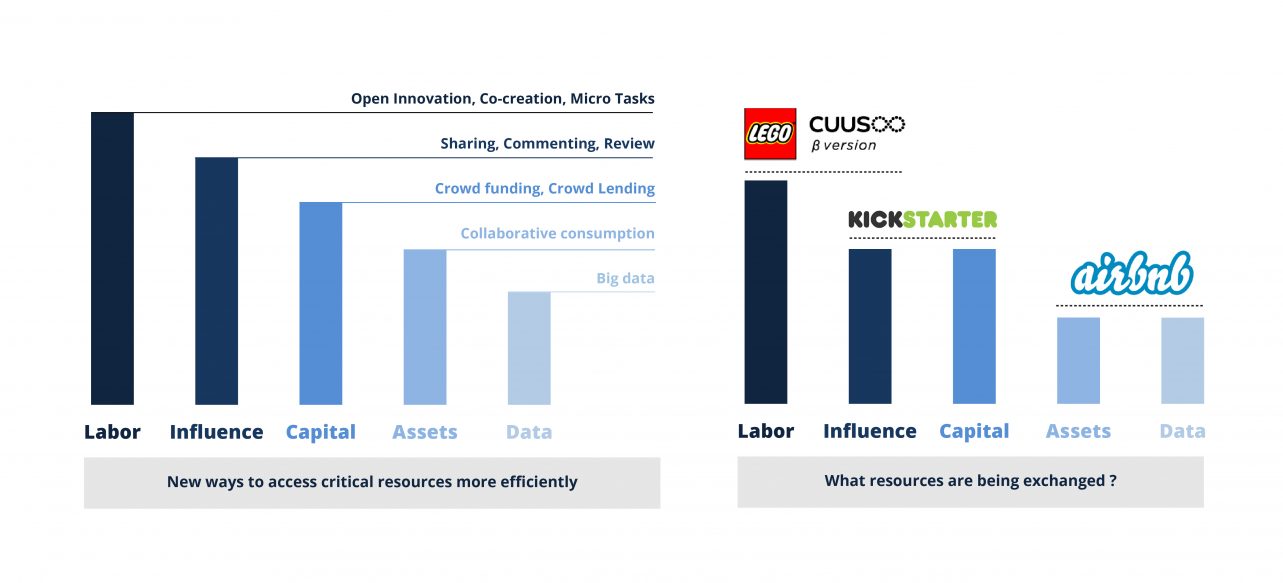
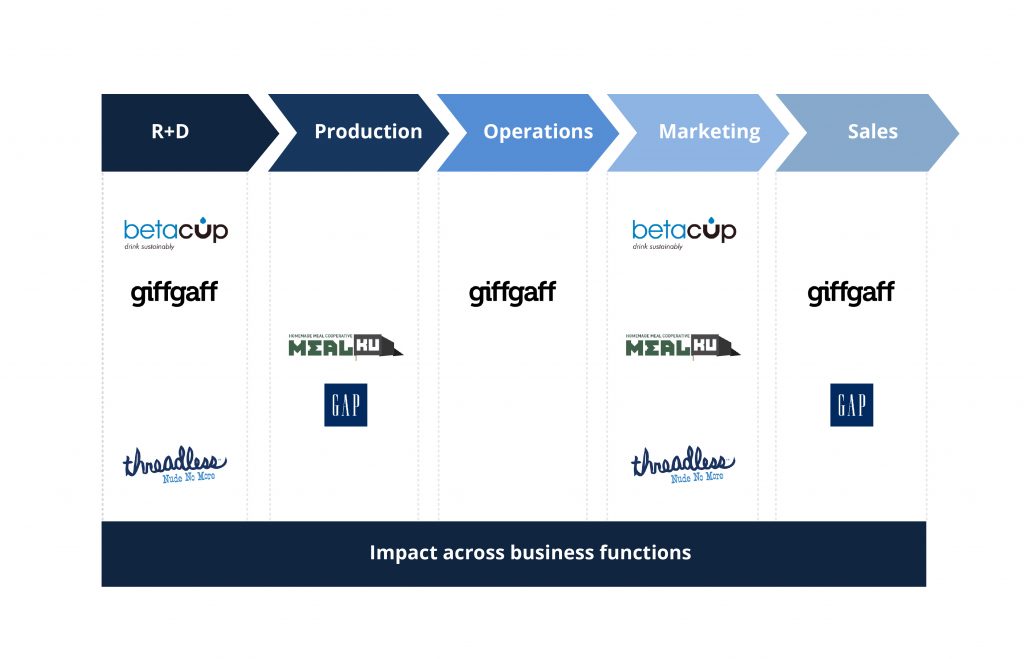
Source: Shaun Abrahamson
The key to unlocking the power of crowdsourcing is to have a thorough understanding of motivating factors behind the people’s actions. They can be anything: monetary rewards, recognition, fame, and more.
Conclusion
One of the best ways to determine the model is to use a business model canvas. The Osterwalder business model canvas is quite comprehensive and can help you generate a business model.
It doesn’t matter whether the product is generic or revolutionary. It is important to master business model innovation for a business to succeed and retain its competitive edge.
Source: https://www.hackerearth.com/blog/innovation-management/8-innovative-business-models/

